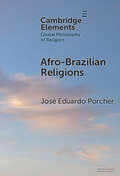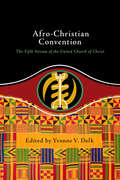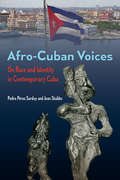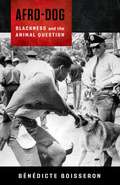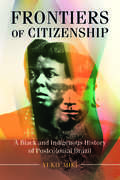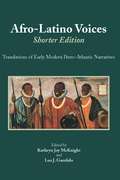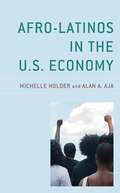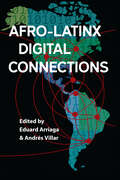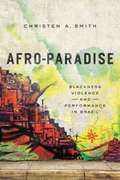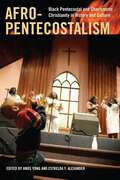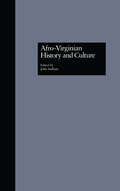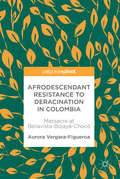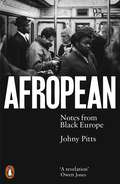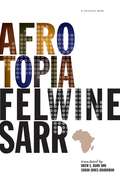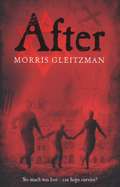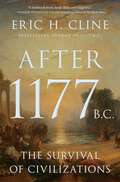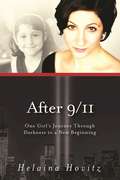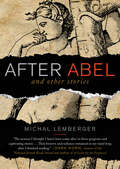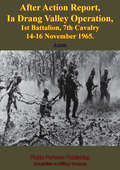- Table View
- List View
Afro-Americans in Antebellum Boston: An Analysis of Probate Records (Studies in African American History and Culture)
by Carol Buchalter StappFirst published in 1993. Routledge is an imprint of Taylor & Francis, an informa company.
Afro-Brazilian Religions (Elements in Global Philosophy of Religion)
by José Eduardo PorcherThis Element introduces Afro-Brazilian religions and underscores the necessity for an expanded methodological framework to encompass these traditions in the philosophy of religion. It emphasizes the importance of incorporating overlooked sources like mythic narratives and ethnographies while acknowledging the pivotal role of material culture in cognitive processes. Furthermore, it advocates for adopting an embodiment paradigm to facilitate the development of a philosophy of religious practice. The Element illustrates this approach by examining phenomena often neglected in philosophical discussions on religion, such as sacrifice and spirit possession, and delves into the ontological commitments and implications of these practices. It also stresses the significance of employing thick descriptions and embracing interdisciplinary dialogue to cultivate a globally inclusive philosophy of religion, capable of engaging with phenomena frequently sidelined within the mainstream.
Afro-Christian Convention: The Fifth Stream of the United Church of Christ
by Yvonne V. DelkThe story of the Afro-Christian Convention, one story of many in the history of the independent Black Church, is the story of faith, survival, affirmation, and empowerment in the hostile environment of racism. From 1892 to the 1960s, the Afro-Christian Convention was composed of 150 churches and 25,000 members, located primarily in North Carolina and Virginia. The tradition of the Afro-Christian church, too long ignored and under-celebrated, takes its rightful place in the canon of United Church of Christ history.
Afro-Cuban Voices: On Race and Identity in Contemporary Cuba (Contemporary Cuba)
by Jean Stubbs Pedro Pérez SarduyFrom the forewords: "At a time when Cuba is undergoing immense economic and social changes, race becomes a kind of cultural litmus test for the national identity. . . . This anthology illustrates fully that it is possible to be both revolutionary and black in Cuba."—Manning Marable, Columbia University "The authors of Afro-Cuban Voices, also key actors in the new, unfolding dialogue about race in Cuba, make a seminal contribution through a forthright critique of ‘racial blind spots’ in official history and present-day racial discrimination."—James Early, director of cultural studies and communication, Smithsonian Institution From the series editor: "A courageous attempt to deal head-on with the issue of race in Cuba today. . . . Pérez Sarduy and Stubbs [seek to] put a human face on this debate, and do so well. The book will be received with relief by some and with frustration by others. Controversial it will undoubtedly be, since—as with most things Cuban—strong emotions are a given assumption. It will be an admirable beginning for the series and, it is hoped, will spark a much-needed debate in the United States on many aspects of the ‘Cuban question.’ It is about time."—John M. Kirk Based on the vivid firsthand testimony of prominent Afro-Cubans who live in Cuba, this book of interviews looks at ways that race affects daily life on the island. While celebrating their racial and national identity, the collected voices express an urgent need to end the silences and distortions of history in both pre- and postrevolutionary Cuba. The 14 people interviewed—of different generations and from different geographic areas of Cuba—come from the arts, the media, industry, academia, and medicine. They include a doctor who calls for joint U.S.-Cuban studies on high blood pressure and a craftsman who makes the batá drums used in Yoruba worship ceremonies. All responded to four controversial questions: What is it like to be black in Cuba? How has the revolution made a difference? To what extent is that difference true today? What can be done? Exposing the contradictions of both racial stereotyping and cultural assimilation, their eloquent answers make the case that the issue of race in Cuba, no matter how hard to define, will not be ignored. A volume in the series Contemporary Cuba, edited by John M. Kirk
Afro-Dog: Blackness and the Animal Question
by Bénédicte BoisseronThe animal-rights organization PETA asked “Are Animals the New Slaves?” in a controversial 2005 fundraising campaign; that same year, after the Humane Society rescued pets in the aftermath of Hurricane Katrina while black residents were neglected, some declared that white America cares more about pets than black people. These are but two recent examples of a centuries-long history in which black life has been pitted against animal life. Does comparing human and animal suffering trivialize black pain, or might the intersections of racialization and animalization shed light on interlinked forms of oppression?In Afro-Dog, Bénédicte Boisseron investigates the relationship between race and the animal in the history and culture of the Americas and the black Atlantic, exposing a hegemonic system that compulsively links and opposes blackness and animality to measure the value of life. She analyzes the association between black civil disobedience and canine repression, a history that spans the era of slavery through the use of police dogs against protesters during the civil rights movement of the 1960s to today in places like Ferguson, Missouri. She also traces the lineage of blackness and the animal in Caribbean literature and struggles over minorities’ right to pet ownership alongside nuanced readings of Derrida and other French theorists. Drawing on recent debates on black lives and animal welfare, Afro-Dog reframes the fast-growing interest in human–animal relationships by positioning blackness as a focus of animal inquiry, opening new possibilities for animal studies and black studies to think side by side.
Afro-Latin America: A Black and Indigenous History of Postcolonial Brazil (Afro-Latin America)
by Yuko MikiFrontiers of Citizenship is an engagingly-written, innovative history of Brazil's black and indigenous people that redefines our understanding of slavery, citizenship, and the origins of Brazil's 'racial democracy'. Through groundbreaking archival research that brings the stories of slaves, Indians, and settlers to life, Yuko Miki challenges the widespread idea that Brazilian Indians 'disappeared' during the colonial era, paving the way for the birth of Latin America's largest black nation. Focusing on the postcolonial settlement of the Atlantic frontier and Rio de Janeiro, Miki argues that the exclusion and inequality of indigenous and African-descended people became embedded in the very construction of Brazil's remarkably inclusive nationhood. She demonstrates that to understand the full scope of central themes in Latin American history - race and national identity, unequal citizenship, popular politics, and slavery and abolition - one must engage the histories of both the African diaspora and the indigenous Americas.
Afro-Latin America: Black Lives, 1600-2000
by George Reid AndrewsOf the almost 11 million Africans who came to the Americas between 1500 and 1870, two-thirds came to Spanish America and Brazil. Over four centuries, Africans and their descendants—both free and enslaved—participated in the political, social, and cultural movements that indelibly shaped their countries’ colonial and post-independence pasts. Yet until very recently Afro-Latin Americans were conspicuously excluded from narratives of their hemisphere’s history.<P><P> George Reid Andrews seeks to redress this damaging omission by making visible the past and present lives and labors of black Latin Americans in their New World home. He cogently reconstructs the Afro-Latin heritage from the paper trail of slavery and freedom, from the testimonies of individual black men and women, from the writings of visiting African-Americans, and from the efforts of activists and scholars of the twentieth century to bring the Afro-Latin heritage fully into public view.<P> While most Latin American countries have acknowledged the legacy of slavery, the story still told throughout the region is one of “racial democracy”—the supposedly successful integration and acceptance of African descendants into society. From the 1970s to today, black civil rights movements have challenged that narrative and demanded that its promises of racial equality be made real. They have also called for fuller acknowledgment of Afro-Latin Americans’ centrality in their countries’ national histories. Afro-Latin America brings that story up to the present, examining debates currently taking place throughout the region on how best to achieve genuine racial equality.
Afro-Latino Voices: Narratives from the Early Modern Ibero-Atlantic World, 1550-1812
by Kathryn Joy Mcknight Leo J. GarofaloA landmark scholarly achievement . . . With judicious commentary by several of the leading experts in the field, this book dramatically expands the canon of texts used to study the black Atlantic and the African diaspora, and captures the tenor of the 'black voice' as it collectively engaged the power of colonial institutions. In no uncertain terms, Afro-Latino Voices will prove to be a remarkable pedagogical tool and an influential resource, inspiring deeper comparative work on the African diaspora. --Ben Vinson III, Center for Africana Studies, Johns Hopkins University
Afro-Latino Voices: Translations of Early Modern Ibero-Atlantic Narratives
by Leo J. Garofalo Kathryn Joy McKnightIdeally suited for use in broad, swift-moving surveys of Latin American and Caribbean history, this abridgment of McKnight and Garofalo's Afro-Latino Voices: Narratives from the Early Modern Ibero-Atlantic World, 1550-1812 (2009) includes all of the English translations, introductions, and annotation created for that volume.
Afro-Latinos in the U. S. Economy
by Michelle Holder Alan A. AjaAfro-Latinos in the U.S. Economy outlines the current position and status of Afro-Latinxs in the economy of the United States. Very little research has thus far been disseminated in the field of economics on the contributions of Afro-Latinxs regarding income and wealth, labor market status, occupational mobility, and educational attainment. On the other hand, cultural studies, literary criticism, and social science fields have produced more research on Afro-Latinxs; the discipline of economics is, thus, significantly behind the curve in exploring the economic dimensions of this group. <p><p>While the Afro-Latinx community constitutes a comparatively small segment of the U.S. population, and is often viewed as the nexus between two of the country’s largest minority groups—African Americans and Latinxs, who comprise 13 percent and 17 percent, respectively, of the U.S. population—Holder and Aja outline how the group’s unique economic position is different than non-black Latinxs. Despite possessing higher levels of education relative to the Latinx community as a whole, U.S. Afro-Latinxs do not experience expected returns in income and earnings, underscoring the role anti-Blackness plays in everyday life regardless of ancestral origin. <p><p>The goal of this book is to provide a foundation in the economic dimensions of Afro-Latinxs in the U.S. which can be used to both complement and supplement research conducted on this group in other major disciplines.
Afro-Latinx Digital Connections (Reframing Media, Technology, and Culture in Latin/o America)
by Eduard Arriaga Andrés VillarHow Black Latinx communities are using digital technology to achieve visibility and social justice This volume presents examples of how digital technologies are being used by people of African descent in South America and the Caribbean, a topic that has been overlooked within the field of digital humanities. These case studies show that in the last few decades, Black Latinx communities have been making themselves visible and asserting long-standing claims and rights through digital tools and platforms, which have been essential for enacting discussions and creating new connections between diverse groups. Afro-Latinx Digital Connections includes both research articles and interviews with practitioners who are working to create opportunities for marginalized communities. Projects discussed in this volume range from an Afrodescendant digital archive in Argentina, blog networks in Cuba, an NGO dedicated to democratizing technology in Brazilian favelas, and the recruitment of digital media to fight racism in Peru. Contributors demonstrate that these tools need not be state of the art to be effective and that they are often most useful when employed to sustain a resilience that is deep and historically grounded. Digital connections are shown here as a means to achieve social justice and to create complex self-representations that challenge racist images of Afrodescendant peoples and monolithic conceptions of humanity. This volume expands the scope of digital humanities and challenges views of the field as a predominantly white discipline. Contributors: Sandra AbdAllah-Álvarez | Adebayo Adegbembo | Maya Anderson-González | Eduard Arriaga | Silvana Bahia | Yvonne Captain | Monica Carrillo | Yancy Castillo | Alí Majul | Maria Cecilia Martino | Andrés Villar A volume in the series Reframing Media, Technology, and Culture in Latin/o America, edited by Héctor Fernández L’Hoeste and Juan Carlos Rodríguez
Afro-Paradise: Blackness, Violence, and Performance in Brazil
by Christen A SmithTourists exult in Bahia, Brazil as a tropical paradise infused with the black population's one-of-a-kind vitality. But the alluring images of smiling black faces and dancing black bodies masks an ugly reality of anti-black authoritarian violence. Christen A. Smith argues that the dialectic of glorified representations of black bodies and subsequent state repression reinforces Brazil's racially hierarchal society. Interpreting the violence as both institutional and performative, Smith follows a grassroots movement and social protest theater troupe in their campaigns against racial violence. As Smith reveals, economies of black pain and suffering form the backdrop for the staged, scripted, and choreographed afro-paradise that dazzles visitors. The work of grassroots organizers exposes this relationship, exploding illusions and asking unwelcome questions about the impact of state violence performed against the still-marginalized mass of Afro-Brazilians.
Afro-Pentecostalism: Black Pentecostal and Charismatic Christianity in History and Culture (Religion, Race, and Ethnicity #16)
by Amos Yong Estrelda Y AlexanderThis &“well researched, illuminating, and highly informative" volume presents a comprehensive, scholarly overview of Black Pentecostal and Charismatic Christianity (Choice). Since the American Pentecostal movement began in the early twentieth century, its African American sector has been markedly influential. Black Christians have been integrally involved in every aspect of the Pentecostal movement, making significant contributions to its founding as well as the evolution of Pentecostal/charismatic styles of worship, preaching, music, engagement of social issues, and theology. Yet despite its being one of the fastest growing segments of the Black Church, Afro-Pentecostalism has not received the kind of critical attention it deserves. Afro-Pentecostalism brings together fourteen interdisciplinary scholars to examine different facets of the movement, including its early history, issues of gender, relations with other black denominations, intersections with popular culture, and missionary activities, as well as the movement&’s distinctive theology. Bolstered by editorial introductions to each section, the chapters reflect on the state of the movement, chart its trajectories, discuss pertinent issues, and anticipate future developments. Contributors: Estrelda Y. Alexander, Valerie C. Cooper, David D. Daniels III, Louis B. Gallien, Jr., Clarence E. Hardy III, Dale T. Irvin, Ogbu U. Kalu, Leonard Lovett, Cecil M. Robeck, Jr., Cheryl J. Sanders, Craig Scandrett-Leatherman, William C. Turner, Jr., Frederick L. Ware, and Amos Yong
Afro-Virginian History and Culture (Crosscurrents in African American History #5)
by John SaillantThe essays in this collection offer new evidence and new conclusions on topics in the history of African Americans in Virginia such as the demography of early slave imports, the means used to regulate slave labor, the situation of female hired slaves in the backcountry, African American women in the Civil War era, and the Garveyite grassroots organizations of the 1920s.
Afrodescendant Resistance to Deracination in Colombia: Massacre at Bellavista-Bojayá-Chocó
by Aurora Vergara-FigueroaThis book provides a socio-historical analysis of the 2002 massacre at Bellavista-Bojay#65533;-Choc#65533;, Colombia. The author examines how the concepts of forced displacement and migration could be formulas for historical erasure. These concepts are used to name populations, such as the survivors of this massacre, and are limited in their ability to contribute to the demands for reparation of the affected populations. Instead, based on an ethnographic study of the pain and suffering generated in the survivors, the book proposes the concept of deracination as a tool to study land dispossession. It captures both the complex local specificities, the global linkages of this phenomenon and the strategies of resistance used by the people of this community to channel what seems as an impossible mourning.
Afropean: Notes from Black Europe
by Johny PittsWinner of the Jhalak Prize'A revelation' Owen Jones'Afropean seizes the blur of contradictions that have obscured Europe's relationship with blackness and paints it into something new, confident and lyrical' Afua Hirsch A Guardian, New Statesman and BBC History Magazine Best Book of 2019 'Afropean. Here was a space where blackness was taking part in shaping European identity ... A continent of Algerian flea markets, Surinamese shamanism, German Reggae and Moorish castles. Yes, all this was part of Europe too ... With my brown skin and my British passport - still a ticket into mainland Europe at the time of writing - I set out in search of the Afropeans, on a cold October morning.'Afropean is an on-the-ground documentary of areas where Europeans of African descent are juggling their multiple allegiances and forging new identities. Here is an alternative map of the continent, taking the reader to places like Cova Da Moura, the Cape Verdean shantytown on the outskirts of Lisbon with its own underground economy, and Rinkeby, the area of Stockholm that is eighty per cent Muslim. Johny Pitts visits the former Patrice Lumumba University in Moscow, where West African students are still making the most of Cold War ties with the USSR, and Clichy Sous Bois in Paris, which gave birth to the 2005 riots, all the while presenting Afropeans as lead actors in their own story.
Afrotopia (Univocal)
by Felwine SarrA vibrant meditation and poetic call for an African utopian philosophy of self-reinvention for the twenty-first century In the recent aftermath of colonialism, civil wars, and the AIDS crisis, a new day finally seems to be shining on the African continent. Africa has once again become a site of creative potential and a vibrant center of economic growth and production. No longer stigmatized by stereotypes or encumbered by the traumas of the past—yet unsure of the future—Africa has other options than simply to follow paths already carved out by the global economy. Instead, the philosopher Felwine Sarr urges the continent to set out on its own renewal and self-discovery—an active utopia that requires a deep historical reflection on the continent&’s vast mythological universe and ancient traditions, nourishes a cultural reinvention, and embraces green technologies for tackling climate change and demographic challenges.Through a reflection on contemporary African writers, artists, intellectuals, and musicians, Sarr elaborates Africa&’s unique philosophies and notions of communal value and economy deeply rooted in its ancient traditions and landscape—concepts such as ubuntu, the life force in Dogon culture; the Rwandan imihigo; and the Senegalese teranga. Sarr takes the reader on a philosophical journey that is as much inward as outward, demanding an elevation of the collective consciousness.Along the way, one sees the contours of an africanity, a contemporary Africa united as a continent through the creolization of its cultural traditions. This is Felwine Sarr&’s Afrotopia.
After
by Morris GleitzmanAfter is the fourth shocking, funny and heartbreaking book in Morris Gleitzman's Second World War series. After The Nazis took my parents I was scared After They killed my best friend I was angry After They ruined my thirteenth birthday I was determined to get to the forest, to join forces with Gabriek and Yuli, to be a family, to defeat the Nazis after all 'Haunting . . . dangerous and desperate, but also full of courage and hope' - Guardian 'You will laugh . . . prepare for shock and tears' - Sunday Times After is the fourth in a series of children's novels about Felix, a Jewish orphan caught in the middle of the Holocaust, from Australian author Morris Gleitzman - author of Bumface and Two Weeks with the Queen. The other books in the series, Once, Then and Now are also available from Puffin.
After 1177 B.C.: The Survival of Civilizations (Turning Points in Ancient History #12)
by Eric H. ClineIn this gripping sequel to his bestselling 1177 B.C., Eric Cline tells the story of what happened after the Bronze Age collapsed—why some civilizations endured, why some gave way to new ones, and why some disappeared forever&“A landmark book: lucid, deep, and insightful. . . . You cannot understand human civilization and self-organization without studying what happened on, before, and after 1177 B.C.&”—Nassim Nicholas Taleb, bestselling author of The Black SwanAt the end of the acclaimed history 1177 B.C., many of the Late Bronze Age civilizations of the Aegean and Eastern Mediterranean lay in ruins, undone by invasion, revolt, natural disasters, famine, and the demise of international trade. An interconnected world that had boasted major empires and societies, relative peace, robust commerce, and monumental architecture was lost and the so-called First Dark Age had begun. Now, in After 1177 B.C., Eric Cline tells the compelling story of what happened next, over four centuries, across the Aegean and Eastern Mediterranean world. It is a story of resilience, transformation, and success, as well as failures, in an age of chaos and reconfiguration.After 1177 B.C. tells how the collapse of powerful Late Bronze Age civilizations created new circumstances to which people and societies had to adapt. Those that failed to adjust disappeared from the world stage, while others transformed themselves, resulting in a new world order that included Phoenicians, Philistines, Israelites, Neo-Hittites, Neo-Assyrians, and Neo-Babylonians. Taking the story up to the resurgence of Greece marked by the first Olympic Games in 776 B.C., the book also describes how world-changing innovations such as the use of iron and the alphabet emerged amid the chaos.Filled with lessons for today's world about why some societies survive massive shocks while others do not, After 1177 B.C. reveals why this period, far from being the First Dark Age, was a new age with new inventions and new opportunities.
After 9/11: One Girl's Journey through Darkness to a New Beginning
by Jasmin Lee Cori Helaina Hovitz“You are a herald for your generation....Thank you for using your voice to help us make sense of that dark day, and forge a new beginning.”—Hillary Rodham Clinton, in a letter to Helaina Hovitz Helaina Hovitz was twelve years old and in middle school just blocks away when the World Trade Center was attacked. Her memoir encapsulates the journey of a girl growing up with PTSD after living through the events firsthand. After 9/11 chronicles its effects on a young girl at the outset of adolescence, following her as she spirals into addiction and rebellion, through loss, chaos, and confusion.The events of 9/11 were a very real part of Helaina’s life and are still vivid in her memory today. Hundreds were stranded in the neighborhood, including Helaina, without phones or electricity or anyone to help. Fear and despair took over her life. It would take Helaina more than a decade to overcome the PTSD — and subsequent alcohol addiction — that went misdiagnosed and mistreated. In many ways, After 9/11 is the story of a generation growing up in the aftermath of America’s darkest day —and for one young woman, it is the story of a survivor who, after witnessing the end, got to make a new beginning. This new trade paperback edition includes tips on how to cope with trauma, an FAQ section, and a guide to discussing 9/11 with children. “Inspirational, courageous and beautifully told. After 9/11 is a testament to the resiliency of the human spirit.” — Cathy Free, correspondent, PEOPLE magazine“Helaina Hovitz's engrossing narrative begins in the shadow of the twin towers with her as a backpack-toting twelve-year-old and plays out over the next fifteen years in dramatic - and sometimes distressing - detail. This impressive debut is both deeply evocative and intensely personal.” — Peter Canby, Senior Editor, The New Yorker“A moving and remarkable testament to a time that changed our country, told beautifully by a young woman who never gave up hope that she could reclaim her life, no matter how grim things looked.” — Sean Elder, contributor, Newsweek
After 9/11: Solutions For A Saner World
by Don Hazen Tate Hausman Tamara Straus Michelle ChiharaEssays, from the progressive point of view, on various aspects of the 9/11 events, their causes, aftermath and what to do so that all may live in a safer, saner world in the future.
After Abel and Other Stories: And Other Stories
by Jonathan Kirsch Michal Lemberger"Her knowledge of the Bible is evident and her creativity shines through as she weaves nine thoughtful and layered accounts of distant, complicated times."-Publisher's Weekly"Reminiscent of Anita Diamant's The Red Tent. . . . These beautifully written stories feel like meeting Eve, Lot's wife, and many other compelling characters for the first time." -LAUREL CORONA, author of The Mapmaker's Daughter and The Four Seasons: A Novel of Vivaldi's Venice"Stunning." -MOLLY ANTOPOL, author of The UnAmericans"Gorgeous and captivating." -DARA HORN, author of A Guide for the Perplexed and The World to Come"Marvelous." -MICHELLE HUNEVEN, author of Off Course and Blame"What struck me most about these stories is their clear, assured confidence-as if Michal Lemberger had pulled apart some of the lines in the old story, spied a new story tucked in there way off in a corner, shimmied in a fishhook and pulled it out." -AIMEE BENDER, author of The Color Master and The Particular Sadness of Lemon Cake"Lemberger liberates the voices that are trapped beneath the [biblical] text . . . with artistry and erudition." -RABBI DAVID WOLPE, Rabbi of Sinai Temple, Los Angeles and author of Why Faith MattersEve considers motherhood.Miriam tends Moses.Lot's wife looks back.Vividly reimagined with startling contemporary clarity, Michal Lemberger's debut collection of short stories gives voice to silent, oft-marginalized biblical women: their ambitions, their love for their children, their values, their tremendous struggles and challenges. Informed by Lemberger's deep knowledge of the Bible, each of these nine stories story recasts a biblical saga from the perspective of a pivotal woman.Michal Lemberger's nonfiction and journalism have appeared in Slate, Salon, Tablet, and other publications, and her poetry has been published in a number of print and online journals. A story from After Abel, her first collection of fiction, was featured in Lilith Magazine. Lemberger holds an MA and PhD in English from UCLA and a BA in English and religion from Barnard College. She has taught the Hebrew Bible as Literature at UCLA and the American Jewish University. She was born and raised in New York and now lives in Los Angeles with her husband and two daughters.
After Action Report, Ia Drang Valley Operation, 1st Battalion, 7th Cavalry 14-16 November 1965
by Anon."The Battle of Ia Drang was the first major battle between regulars of the United States Army and regulars of the People's Army of Vietnam (PAVN / NVA) of North Vietnam during the Vietnam War. The two-part battle took place between November 14 and November 18, 1965, at two landing zones (LZs) northwest of Plei Me in the Central Highlands of South Vietnam (approximately 35 miles south-west of Pleiku) as part of the U.S. airmobile offensive codenamed Operation Silver Bayonet. The battle derives its name from the Drang River which runs through the valley northwest of Plei Me, in which the engagement took place. Ia means "river" in the local Montagnard language.Representing the American forces were elements of the 3rd Brigade, 1st Cavalry Division: the 1st Battalion and 2nd Battalion of the 7th Cavalry Regiment, and the 2nd Battalion, 5th Cavalry Regiment of the United States Army, facing elements of the B3 Front of the PAVN (including the 304 Division) and Viet Cong. The battle involved close air support by U.S. aircraft and a strategic bombing strike by the B-52s. The initial Vietnamese assault against the landing 1st Battalion, 7th Cavalry at LZ X-Ray was repulsed after two days and nights of heavy fighting on November 14-16. However, the follow-up surprise attack on November 17 that overran the marching column of 7th Cavalry 2nd Battalion near the LZ Albany was the deadliest ambush of a U.S. unit during the course of the entire war. About half of some 300 American deaths in the 35-day Operation Silver Bayonet happened in just this one fight that lasted 16 hours."-Wiki
After Acts: Exploring the Lives and Legends of the Apostles
by Bryan LitfinWhat really happened after Acts?If you&’ve ever wondered what happened to the biblical characters after Acts—from the well-known Matthew to the lesser-known Bartholomew—then this book is for you. Join Dr. Bryan Litfin as he guides you through Scripture and other ancient literature to sift fact from fiction, real-life from legend. Skillfully researched and clearly written, After Acts is as accurate as it is engaging. Gain a window into the religious milieu of the ancient and medieval church. Unearth artifacts and burial sites. Learn what really happened to your favorite characters and what you should truly remember them for.Did Paul ever make it to Spain? Was he beheaded in Rome?Is it true that Peter was crucified upside down?Was the Virgin Mary really bodily assumed into heaven?The book of Acts ends at chapter 28. But its characters lived on.
After Acts: Exploring the Lives and Legends of the Apostles
by Bryan LitfinWhat really happened after Acts?If you&’ve ever wondered what happened to the biblical characters after Acts—from the well-known Matthew to the lesser-known Bartholomew—then this book is for you. Join Dr. Bryan Litfin as he guides you through Scripture and other ancient literature to sift fact from fiction, real-life from legend. Skillfully researched and clearly written, After Acts is as accurate as it is engaging. Gain a window into the religious milieu of the ancient and medieval church. Unearth artifacts and burial sites. Learn what really happened to your favorite characters and what you should truly remember them for.Did Paul ever make it to Spain? Was he beheaded in Rome?Is it true that Peter was crucified upside down?Was the Virgin Mary really bodily assumed into heaven?The book of Acts ends at chapter 28. But its characters lived on.

